seats PONTIAC FIREBIRD 1994 Owners Manual
[x] Cancel search | Manufacturer: PONTIAC, Model Year: 1994, Model line: FIREBIRD, Model: PONTIAC FIREBIRD 1994Pages: 290, PDF Size: 14.84 MB
Page 2 of 290
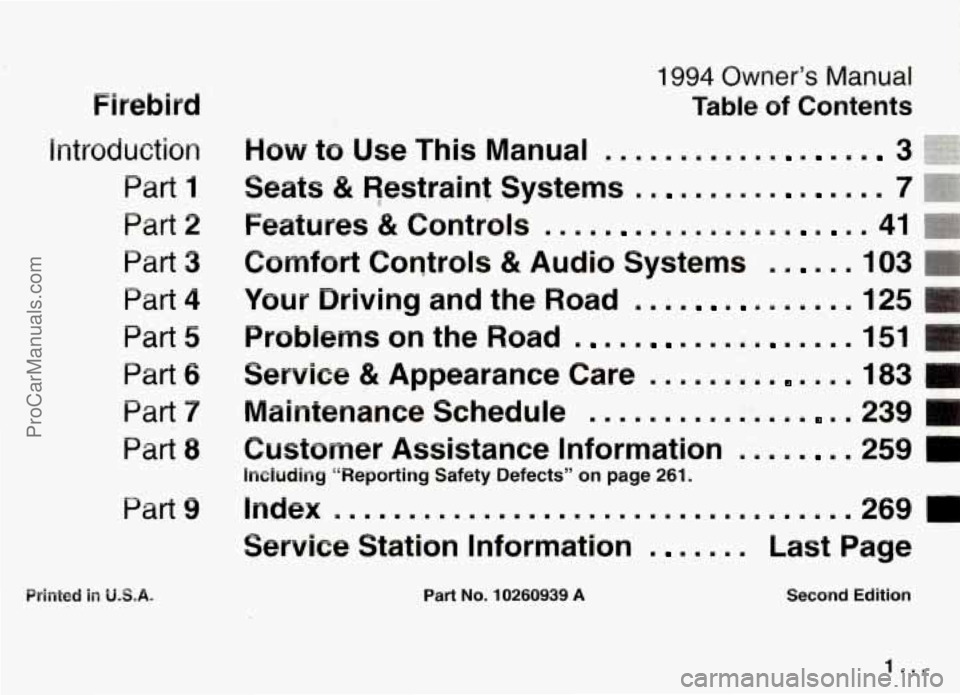
Firebird
1994 0wn:er’s Manual
Table of Contents
Introduction
Part 1
Part 2
Part 3
Part 4
Part 5
Part 6
Part 9
Part 8
Part 9
How to Use This Manual ,, 3
Seats
& Restraint 6 Systems 7
Features & Controls m 41
Comfort Coqtrols
& Audio Systems 103
Your Driving and the
Road m 125
Probiems
on the Road = 151
& Appearance Care m =. 183
Maintenance Schedule
A = 239
Customer Assistance Information
m 259
Including “Reporting Safety Defects” on page 261.
hdeX smmmm=m.====mmmmm==.mm=mmmmm==m=mmm 269
Servi.ce Station Information
Last Page
Printed in U.S.A. Part No. 10260939 A Second Edition
1 ...
ProCarManuals.com
Page 4 of 290
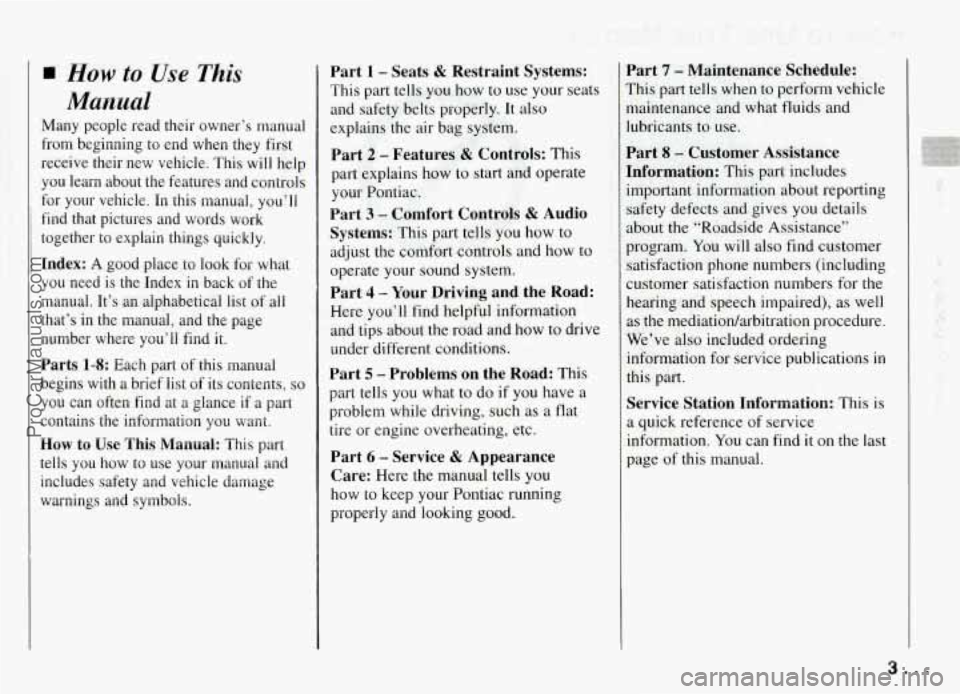
How to Use This
Manual
Many people read their owner’s manual
from beginning to end when they first
receive their new vehicle. This will help you learn about the features and controls
for your vehicle. In this manual, you’ll
find that pictures and words work
together to explain things quickly.
~ Index: A good place to look for what
you need is the Index
in back of the
manual. It’s an alphabetical list of all
that’s in the manual, and the page
number where you’ll find it.
Parts 1-8: Each part of this manual
begins with a brief list of its contents,
so
you can often find at a glance if a part
contains the information you want.
How to Use This Manual: This part
tells you how to use your manual and
includes safety and vehicle damage
warnings and symbols.
Part 1 - Seats & Restraint Systems:
This part tells you how to use your seats
and safety belts properly.
It also
explains the air bag system.
Part 2 - Features & Controls: This
part explains how to start and operate
your Pontiac.
Part 3 - Comfort Controls & Audio
Systems:
This part tells you how to
adjust the comfort controls and how
to
operate your sound system.
Part 4 - Your Driving and the Road:
Here you’ll find helpful information
and tips about the road and how to drive
under different conditions.
Part 5 - Problems on the Road: This
part tells you what to do if you have a
problem while driving, such as a flat
tire or engine overheating, etc.
Part 6 - Service & Appearance
Care:
Here the manual tells you
how to keep your Pontiac running
properly and looking good.
Part 7 - Maintenance Schedule:
This part tells when to perform vehicle
maintenance and what fluids and
lubricants to use.
Part 8 - Customer Assistance
Information:
This part includes
important information about reporting
safety defects and gives
you details
about the “Roadside Assistance” program.
You will also find customer
satisfaction phone numbers (including
customer satisfaction numbers for the
hearing and speech impaired), as well
as the mediatiodarbitration procedure.
We’ve also included ordering
information for service publications in
this part.
Service Station Information: This is
a quick reference of service
information.
You can find it on the last
page of this manual.
3...
ProCarManuals.com
Page 8 of 290
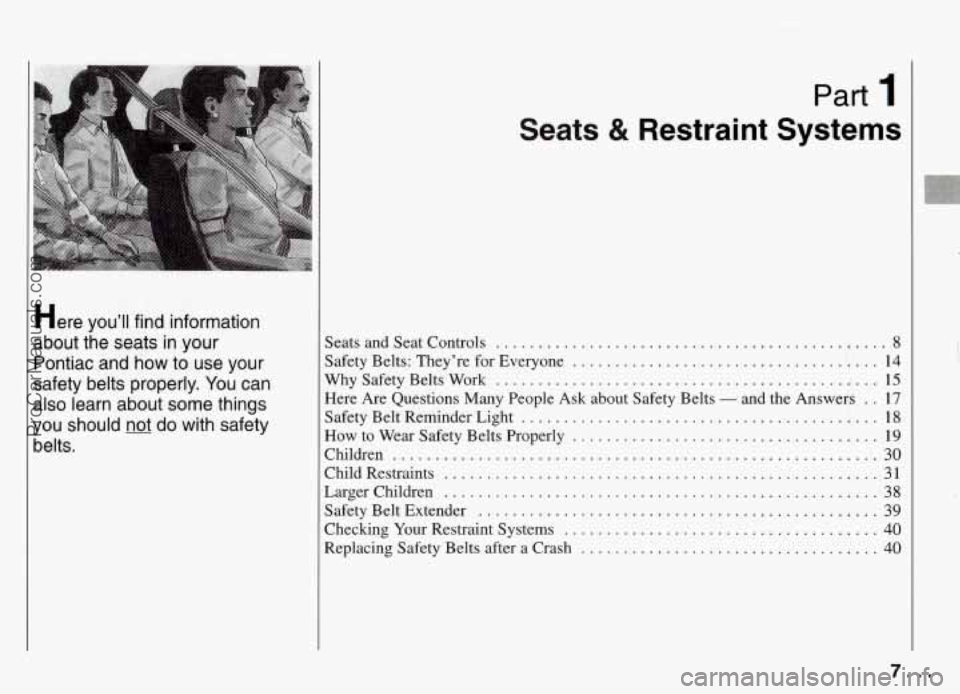
Here you’ll find information
about the seats in
your
Pontiac and how to use your
safety belts properly.
You can
also learn about
some things
you should
not do with safety
belts.
Part 1
Seats & Restraint Systems
..’,
Seats and Seat Controls ............ ........... 8
Safety Belts: They’re for Everyone
........ ..................... 14
Why Safety Belts Work ............................................. 15
Here Are Questions Many People
Ask about Safety Belts - and the Answers . . 17
Safety Belt Reminder Light
.......................................... 18
How
to Wear Safety Belts Properly .................................... 19
Children ................................. ..................... 30
Child Restraints
...... .............. ..................... 31
Larger Children
........................... ..................... 38
SafetyBeltExtender
............................................... 39
Checking Your Restraint Systems
..................................... 40
Replacing Safety Belts after a Crash ................................... 40
c
?..-
ProCarManuals.com
Page 9 of 290
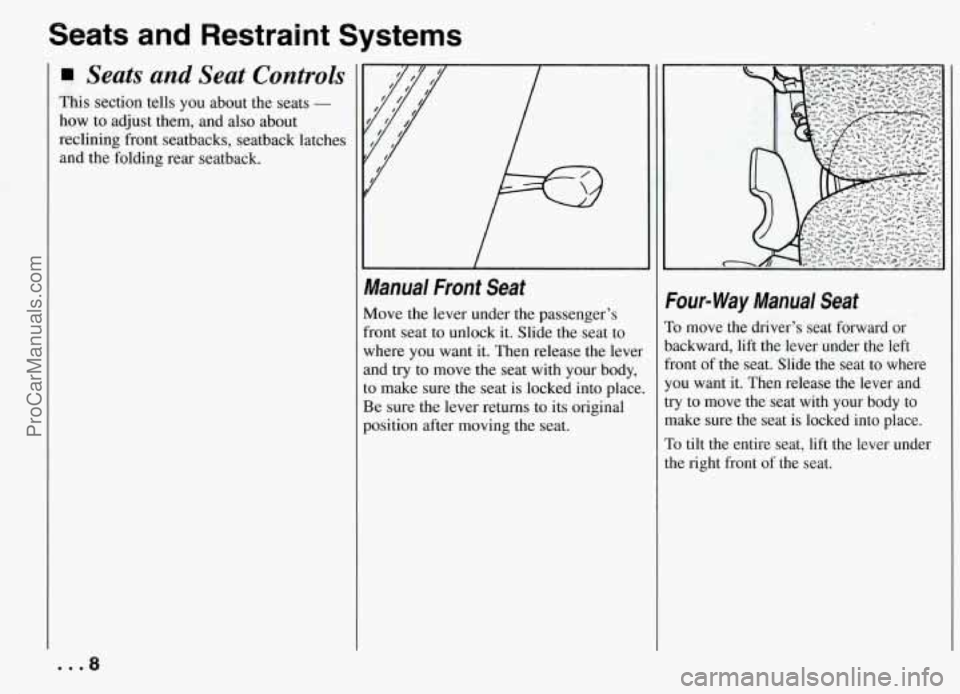
Seats and Restraint Systems
Seats and Seat Controls
This section tells you about the seats -
how to adjust them, and also about
reclining front seatbacks, seatback latches and the folding rear seatback.
Manual Front Seat
Move the lever under the passenger’s
front seat to unlock it. Slide the seat to
where you want it. Then release
the lever
and try to move the seat with your body,
to make sure the seat is locked into place.
Be sure the lever returns to its original
position after moving the seat.
rour-Way Manual Seat
?o move the driver’s seat forward or
backward, lift the lever under the left
ront of the seat. Slide the seat to where
rou want it. Then release the lever and
ry to move the seat with your body to
nake sure the seat is locked into place.
:o tilt the entire seat, lift the lever under
he right front of the seat.
...a
ProCarManuals.com
Page 10 of 290
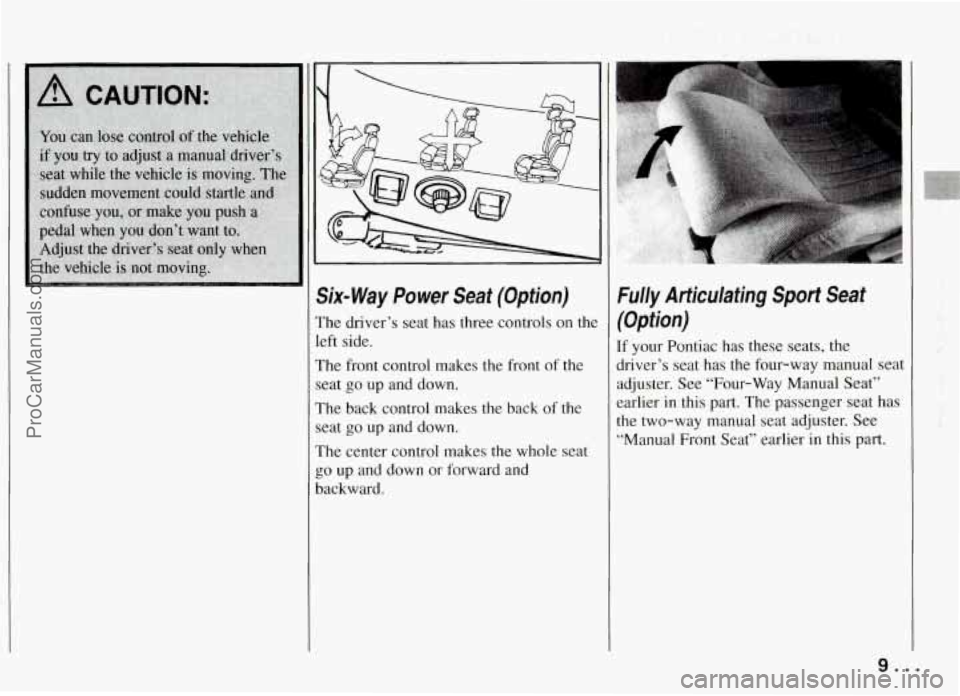
Six-Way Power Seat (Option)
The driver’s seat has three controls on thc
eft side.
rhe front control makes the front of the
;eat go up and down.
The back control makes
the back of the
;eat
go up and down.
The center control makes the whole seat
;o up and down or forward and
Jackward.
Fully Articulating Sport Seat
(Option)
If your Pontiac has these seats, the
driver’s seat has the four-way manual seat
adjuster. See “Four-Way Manual Seat”
earlier
in this part. The passenger seat has
the two-way manual seat adjuster. See
“Manual Front Seat” earlier in this part.
9...
ProCarManuals.com
Page 11 of 290

Seats and Restraint Systems
To adjust the thigh support, pull up on the
front
of your seat cushion and move the
support to the position you want.
To
release the support, continue pulling up.
To engage it again, push down firmly.
The switch pads on the outer sides
of the
seats “inflate” and “deflate” parts
of your
seatback. The
two buttons that have “dots” inflate
md deflate the outer parts of the seatback.
To inflate, push the raised button. To
leflate, push the indented button.
. . .IO
ProCarManuals.com
Page 12 of 290

The two buttons without “dots” inflate
and deflate the lumbar (lower
part of the
seatback) support. To inflate, push the
raised button.
To deflate, push the
indented button.
To adjust the seatback, lift the lever on
the outer side of the seat. Release the
lever
to lock the seatback where you
want it. Pull up on the lever, and the
seat will -go to its original upright
position. But don’t have the seatback
reclined if
your vehicle is moving.
If you have fully articulating sport seats,
your recliner lever looks like this,,
I1 II ...
ProCarManuals.com
Page 13 of 290

Seats and Restraint Systems
Head Restraints
Slide the head restraints up or down so
that the top of the restraint is closest to
the top of your ears.
This position reduces the chance of a
neck injury in a crash.
If you have the fully articulating sport
seat, you have a six-way head restraint.
It can be adjusted up and down, forward
and rearward, or tilted.
To adjust it forward, pull the restraint
forward.
To adjust it rearward, pull the
restraint forward all the way to release
it. Then move it to the position you
want.
. . .12
ProCarManuals.com
Page 15 of 290

Seats and Restraint Systems
Safety Belts: They’re
for Everyone
This part of the manual tells you how to
use safety belts properly. It also tells you
some things you should not do with safety
belts. And it explains the Supplemental
Inflatable Restraint, or “air bag” system.
’his figure lights up as a reminder to
uckle up. (See “Safety Belt Reminder
.ight” in the Index.)
n many states and Canadian provinces,
he law says to wear safety belts. Here’s
vhy: They work.
You never know if you’ll be in a crash. If
you do have a crash, you don’t know
if it
will be a bad one.
A few crashes are mild, and some crashes
can be
so serious that even buckled up a
person wouldn’t survive. But most
crashes are in between. In many of them,
people who buckle up can survive and sometimes walk away. Without belts they
could have been badly hurt or killed.
After more than
25 years of safety belts in
vehicles, the facts are clear. In most
crashes buckling up does matter
... a lot!
. . .I4
ProCarManuals.com
Page 17 of 290

Seats and Restraint Systems
Put someone on it.
Get it up to speed. Then stop the vehicle.
The rider doesn't stop. The
person keeps going until stopped by
something.
In
a real vehicle, it could be the
windshield
. . .
. . .I6
ProCarManuals.com